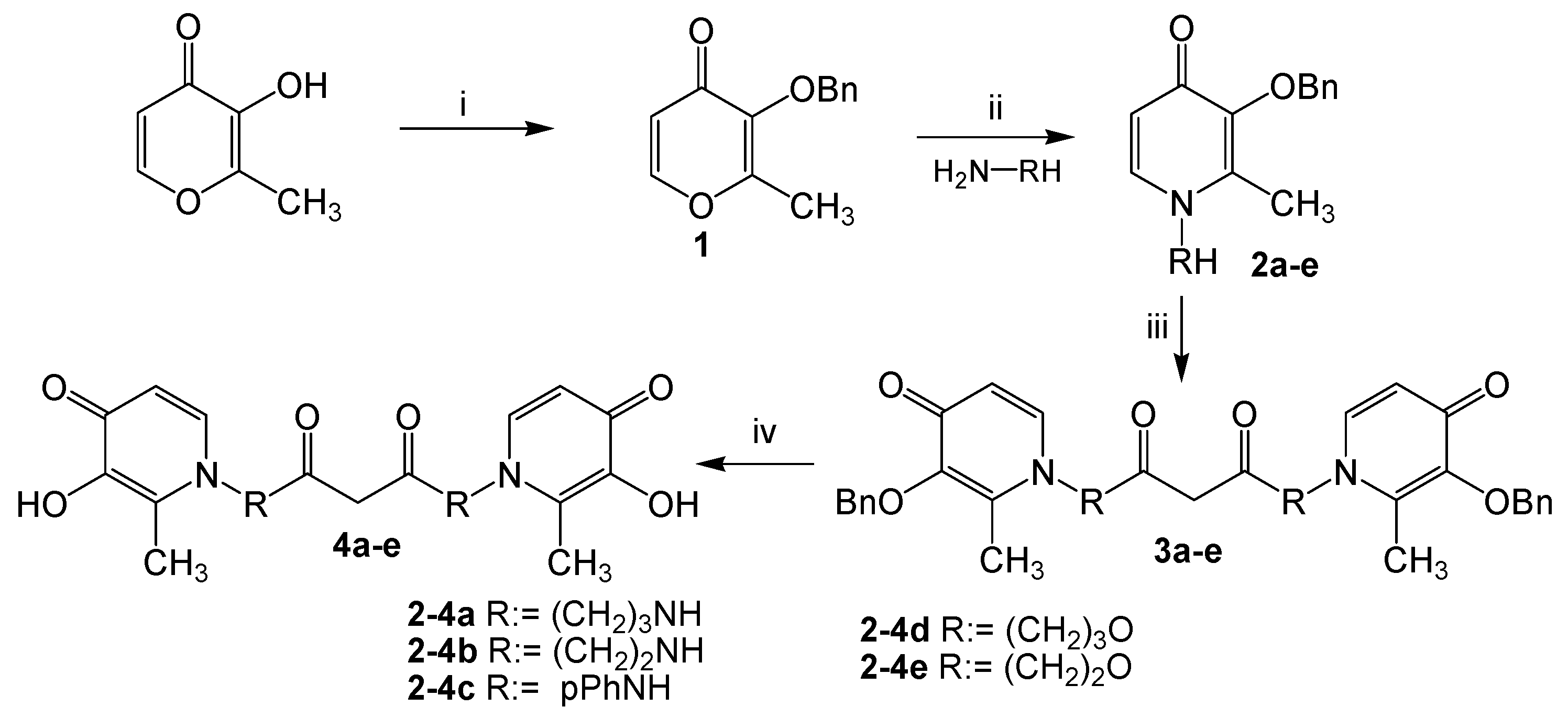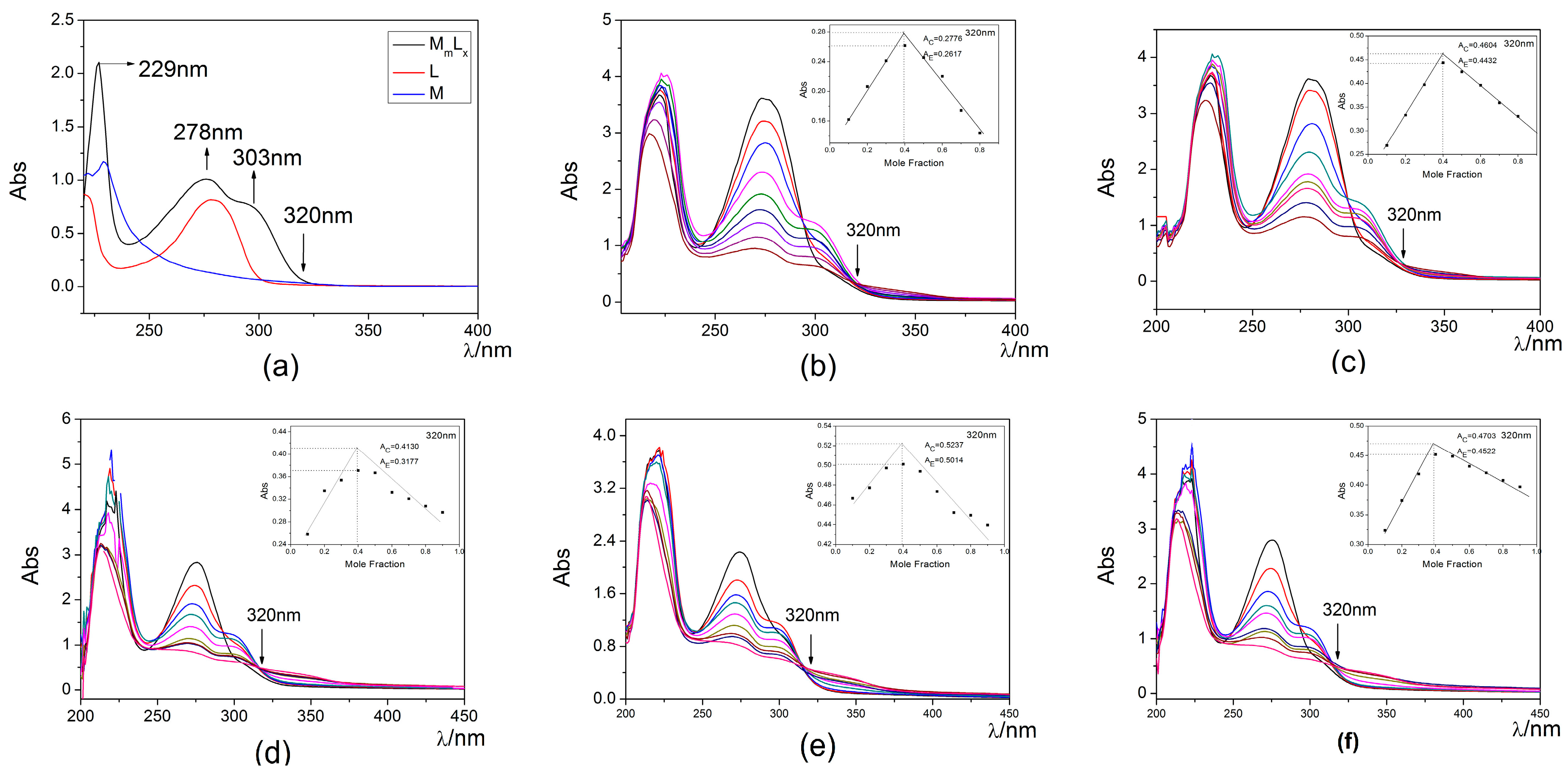Synthesis of New Bis(3-hydroxy-4-pyridinone) Ligands as Chelating Agents for Uranyl Complexation
Abstract
:1. Introduction
2. Results and Discussion
2.1. Synthesis
2.2. Characterization
2.3. Complexation
| 2 M | + | 3 L | = | M2L3 | |
| Initial concentration: | xC | (1 − x)C | 0 | ||
| Equilibrium concentration: | [M]E | [L]E | [M2L3]E | ||
| Complete reaction: | 0 | 0 | [M2L3]C |
3. Materials and Methods
3.1. General
3.2. Synthesis
3.3. Metal Complexation Solutions
4. Conclusions
Acknowledgments
Author Contributions
Conflicts of Interest
References
- Hamilton, J.G. The metabolic properties of the fission products and actinide elements. Rev. Mod. Phys. 1948, 20, 718–728. [Google Scholar] [CrossRef]
- Brugge, D.J.; Lemos, L.D.; Oldmixon, B. Exposure pathways and health effects associated with chemical and radiological toxicity of natural uranium: A review. Rev. Environ. Health 2005, 20, 177–193. [Google Scholar] [CrossRef] [PubMed]
- Morss, L.R.; Edelstein, N.M.; Fuger, J.; Katz, J.J. The Chemistry of the Actinide and Transactinide Elements; Springer: Dordrecht, The Netherlands, 2006; pp. 3339–3440. [Google Scholar]
- Guzmán, L.; Durán-Lara, E.F.; Donoso, W.; Nachtigall, F.M.; Santos, L.S. In Vivo Nanodetoxication for acute uranium exposure. Molecules 2015, 20, 11017–11033. [Google Scholar] [CrossRef] [PubMed]
- Liu, G.; Bruenger, F.W.; Miller, S.C.; Afri, A.M. Molecular structure and biological and pharmacological properties of 3-hydroxy-2-methyl-1-(β-d-ribofuranosyl or pyranosyl)-4-pyridinone: Potential iron overload drugs for oral administration. Bio. Med. Chem. Lett. 1998, 8, 3007–3080. [Google Scholar] [CrossRef]
- Santos, M.A.; Gil, M.; Marques, S.; Gano, L.; Cantinho, G.J. N-Carboxyalkyl derivatives of 3-hydroxy-4-pyridinones: Synthesis, complexation with Fe(III), Al(III) and Ga(III) and in vivo evaluation. J. Inorg. Biochem. 2002, 92, 43–54. [Google Scholar] [CrossRef]
- Santos, M.A.; Gama, S.; Gano, L.; Farkas, E. Bis(3-hydroxy-4-pyridinone)-EDTA derivative as a potential therapeutic Al-chelating agent. Synthesis, solution studies and biological assays. J. Inorg. Biochem. 2005, 99, 1845–1852. [Google Scholar] [CrossRef] [PubMed]
- Santos, M.A.; Grazina, R.; Buglyo, P.; Gama, S.; Farkas, E. A new bipodal carboxy-bis (hydroxypyridinonate) ligand. Synthesis and complexation with copper(II), nicker(II) and zinc(II) in aqueous solution. Polyhedron 2002, 21, 2609–2616. [Google Scholar]
- Leite, A.; Silva, A.M.G.; Nunes, A.; Andrade, M.; Sousa, C.; Silva, L.C.; Gameiro, P.; Castro, B.D.; Rangel, M. Novel tetradentate chelators derived from 3-hydroxy-4-pyridinone units: synthesis, characterization and aqueous solution properties. Tetrahedron 2011, 67, 4009–4016. [Google Scholar] [CrossRef]
- Zhou, T.; Liu, Z.D.; Neubert, H.; Kong, X.L.; Ma, Y.M.; Hider, R.C. High affinity iron(III) scavenging by a novel hexadentate 3-hydroxypyridin-4-one-based dendrimer: Synthesis and characterization. Bioorg. Med. Chem. Lett. 2005, 15, 5007–5011. [Google Scholar] [CrossRef] [PubMed]
- Grazina, R.; Gano, L.; Šebestík, J.; Santos, M.A. New tripodal hydroxypyridinone based chelating agents for Fe(III), Al(III) and Ga(III): Synthesis, physico-chemical properties and bioevaluation. J. Inorg. Biochem. 2009, 103, 262–273. [Google Scholar] [CrossRef] [PubMed]
- Salaheldin, A.M.; Al-Sheikh, M.A. β-Enamino esters in heterocyclic synthesis: Synthesis of pyrazolone and pyridinone derivatives. Molecules 2010, 15, 4359–4368. [Google Scholar] [CrossRef] [PubMed]
- Xu, B.; Kong, X.L.; Zhou, T.; Qiu, D.H.; Chen, Y.L.; Li, M.S. Synthesis, iron(III)-binding affinity and in vitro evaluation of 3-hydroxypyridin-4-one hexadentate ligands as potential antimicrobial agents. Bioorg. Med. Chem. Lett. 2011, 21, 6376–6380. [Google Scholar] [CrossRef] [PubMed]
- Santos, M.A.; Marques, S.M.; Chaves, S. Hydroxypyridinones as privileged chelating structures for the design of medicinal drugs. Coord. Chem. Rev. 2012, 256, 240–259. [Google Scholar] [CrossRef]
- Crisponi, G.; Remeli, M. Iron chleating agent for the treatment of iron overload. Coord. Chem. Rev. 2008, 252, 1225–1240. [Google Scholar] [CrossRef]
- Santos, M.A. Recent development on 3-hydroxy-4-pyridinones with respect to their clinical applications Mono and combined ligand approaches. Coord. Chem. Rev. 2008, 252, 1213–1224. [Google Scholar] [CrossRef]
- Gama, S.; Gil, M.; Gano, L.; Farkas, E.; Santos, M.A. Combined chelation of bi-functional bis-hydroxypiridinone and mono-hydroxypiridinone: Synthesis, solution and in vivo evaluation. J. Inorg. Biochem. 2009, 103, 288–298. [Google Scholar] [CrossRef] [PubMed]
- Santos, M.A.; Gama, S.; Gano, L.; Cantinho, G.; Frakas, E. A new bis(3-hydroxy-4-pyridinone)-IDA derrivatives as a potential therapeutic chelating agent. Synthesis,metal-complexation and biological assays. Dalton Trans. 2004, 21, 3772–3781. [Google Scholar] [CrossRef] [PubMed]
- Zhou, T.; Neubert, H.; Liu, D.Y.; Liu, Z.D.; Ma, Y.M.; Kong, X.L.; Luo, W. Iron dendrimers: A novel approach for the treatment of Haemochromatosis. J. Med. Chem. 2006, 49, 4171–4182. [Google Scholar] [CrossRef] [PubMed]
- Leydier, A.; Lecerclé, D.; Rostaing, S.P.; Reguillon, A.F.; Taran, F.; Lemaire, M. Sequestering agent for uranyl chelation: New binaphtyl ligands. Tetrahedron Lett. 2011, 52, 3973–3977. [Google Scholar] [CrossRef]
- Hider, R.C.; Roy, S.; Ma, Y.M.; Kong, X.L.; Preston, J. The potential application of iron chelators for the treatment of neurodegenerative disease. Metallomics 2011, 3, 239–249. [Google Scholar] [CrossRef] [PubMed]
- Santos, M.A.; Grazina, R.; Neto, A.Q.; Cantinho, G.; Gano, L.; Patrício, L. Synthesis, chelating poperties towards gallium and biological evaluation of two N-substituted 3-hydroxy-4-pyridinones. J. Inorg. Biochem. 2000, 78, 303–311. [Google Scholar] [CrossRef]
- Leydier, A.; Lecerclé, D.; Rostaing, S.P.; Réguillona, A.F.; Taran, F.; Lemairea, M. Sequestering agents for uranyl chelation: New calixarene ligands. Tetrahedron 2008, 64, 11319–11324. [Google Scholar] [CrossRef]
- Hoehne, M.S.; Deblonde, G.J.P.; Abergel, R.J. Solution thermodynamic evaluation of hydroxypyridinonate chelators 3,4,3-LI(1,2-HOPO) and 5-LIO(Me-3,2-HOPO) for UO2(VI) and Th(IV) decorporation. Radiochim. Acta 2013, 101, 359–366. [Google Scholar] [CrossRef]
- Szigethy, G.; Raymond, K.N. Hexadentate Terephthalamide (bis-hydroxypyridinone) ligands for uranyl chelation: Structural and thermodynamic consequences of ligand variation. J. Am. Chem. Soc. 2011, 133, 7942–7956. [Google Scholar] [CrossRef] [PubMed]
- Chaves, S.; Capelo, A.; Areias, L.; Marpues, S.M.; Gano, L.; Esteves, M.A.; Santos, M.A. A novel tripodal tris-hydroxypyrimidinone sequestering agent for trivalent hard metal ions: Synthesis, complexation and in vivo studies. Dalton Trans. 2013, 42, 6033–6045. [Google Scholar] [CrossRef] [PubMed]
- Bartholomä, M.D. Recent developments in the design of bifunctional chelators for metal-based radiopharmaceuticals used in positron emission tomography. Inorg. Chim. Acta 2012, 389, 36–51. [Google Scholar] [CrossRef]
- Chaves, S.; Marques, S.M.; André, M.F. New tris(hydroxypyridinones) as iron and aluminium sequestering agents: Synthesis, complexation and in vivo studies. Chem. Eur. J. 2010, 16, 10535–10545. [Google Scholar] [CrossRef] [PubMed]
- Xu, J.D.; Raymond, K.N. Uranyl sequestering agents: Correlation of properties and efficacy with structure for UO22+ complexes of linear tetradentate 1-methyl-3-hydroxy-2(1H)-pyridinone ligands. Inorg. Chem. 1999, 38, 308–315. [Google Scholar] [CrossRef]
- Domingo, J.L.; Ortega, A.; Llobet, J.M.; Paternain, J.L.; Corbella, J. The effects of uranium on reproduction, gestation, and postnatal survival in mice. Res. Commun. Pathol. Pharmacol. 1989, 64, 161–164. [Google Scholar]
- Stradling, G.N.; Gray, S.A.; Moody, J.C.; Ellender, M. Efficacy of Tiron for Enhancing the Excretion of Uranium from the Rat. Hum. Exp. Toxicol. 1991, 10, 195–198. [Google Scholar] [CrossRef] [PubMed]
- Sample Availability: not availiable.



| L | logKcondU-L/(pH = 7.4) |
|---|---|
| 4a | 21.7 |
| 4b | 22.7 |
| 4c | 18.6 |
| 4d | 21.4 |
| 4e | 22.2 |
© 2016 by the authors. Licensee MDPI, Basel, Switzerland. This article is an open access article distributed under the terms and conditions of the Creative Commons by Attribution (CC-BY) license ( http://creativecommons.org/licenses/by/4.0/).
Share and Cite
Jin, B.; Zheng, R.; Peng, R.; Chu, S. Synthesis of New Bis(3-hydroxy-4-pyridinone) Ligands as Chelating Agents for Uranyl Complexation. Molecules 2016, 21, 299. https://doi.org/10.3390/molecules21030299
Jin B, Zheng R, Peng R, Chu S. Synthesis of New Bis(3-hydroxy-4-pyridinone) Ligands as Chelating Agents for Uranyl Complexation. Molecules. 2016; 21(3):299. https://doi.org/10.3390/molecules21030299
Chicago/Turabian StyleJin, Bo, Rongzong Zheng, Rufang Peng, and Shijin Chu. 2016. "Synthesis of New Bis(3-hydroxy-4-pyridinone) Ligands as Chelating Agents for Uranyl Complexation" Molecules 21, no. 3: 299. https://doi.org/10.3390/molecules21030299
APA StyleJin, B., Zheng, R., Peng, R., & Chu, S. (2016). Synthesis of New Bis(3-hydroxy-4-pyridinone) Ligands as Chelating Agents for Uranyl Complexation. Molecules, 21(3), 299. https://doi.org/10.3390/molecules21030299





